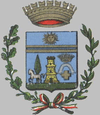Biancavilla
From Wikipedia, the free encyclopedia
| Biancavilla | ||
|---|---|---|
| Comune | ||
| Comune di Biancavilla | ||
 | ||
| ||
 Biancavilla | ||
| Coordinates: 37°39′N 14°52′E / 37.650°N 14.867°ECoordinates: 37°39′N 14°52′E / 37.650°N 14.867°E | ||
| Country | Italy | |
| Region | Sicily | |
| Province | Catania (CT) | |
| Government | ||
| • Mayor | Giuseppe Glorioso (since June 26, 2013) | |
| Area | ||
| • Total | 70 km2 (30 sq mi) | |
| Elevation | 513 m (1,683 ft) | |
| Population (July 2006) | ||
| • Total | 23,433 | |
| • Density | 330/km2 (870/sq mi) | |
| Demonym | Biancavillesi | |
| Time zone | CET (UTC+1) | |
| • Summer (DST) | CEST (UTC+2) | |
| Postal code | 95033 | |
| Dialing code | 095 | |
| Patron saint | San Placido and Maria SS. dell'Elemosina | |
| Saint day | 4-October 6 | |
| Website | Official website | |
Biancavilla is a town and comune in the Province of Catania, Sicily, southern Italy. It is located between the towns of Adrano and S. Maria di Licodia, 32 kilometers northwest of Catania.
The town was founded on 8 January 1488 by Albanian refugees. Led by Cesare Masi, they arrived in an area called Callicari and received the "Licentia Populandi" privilege from Santapau and Centelles, the presidents of the region of Sicily. Therefore, Albanian people established in that area and founded the town. The area was subsequently called Albavilla until in the year 1599 the name became Biancavilla.
| |||||||||||||||||||||||
References
This article is issued from Wikipedia. The text is available under the Creative Commons Attribution/Share Alike; additional terms may apply for the media files.
